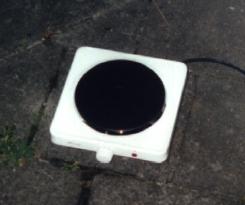 Wednesday 12 april: in Hamme I pass by coincidence
a shop called Super 5000, and also by coincidence I find an
electric 1600W cooking plate (746 fr).
Wednesday 12 april: in Hamme I pass by coincidence
a shop called Super 5000, and also by coincidence I find an
electric 1600W cooking plate (746 fr).
 Wednesday 12 april: in Hamme I pass by coincidence
a shop called Super 5000, and also by coincidence I find an
electric 1600W cooking plate (746 fr).
Wednesday 12 april: in Hamme I pass by coincidence
a shop called Super 5000, and also by coincidence I find an
electric 1600W cooking plate (746 fr).
Saturday 15 april: at Schleiper in Ghent I buy a bottle of line oil (75ml, purified, 109fr) and a bottle of turpentine (1 litre, 230 fr). The line oil and the turpentine are used along with bee wax to make pitch softer and less brittle.
Tuesday 18 april:8PM: I cut the pitch into pieces. The pitch comes in a kind of can that is open at the top. With a screwdriver as chitel and a hammer, I cut the pitch into little pieces; to avoid that the bits of pitch fly around everywhere, I put everything into a plastic bag. I'm busy with this for an hour and 15 minutes and it's been enough for today; let's try if these things want to melt also. Alas, there's no power cord long enough in here (I found out that of course *after* having installed all the other equipment). So I use the rest of the pitch to react off my feelings :-) After another half hour, everything is reduced to little pieces.
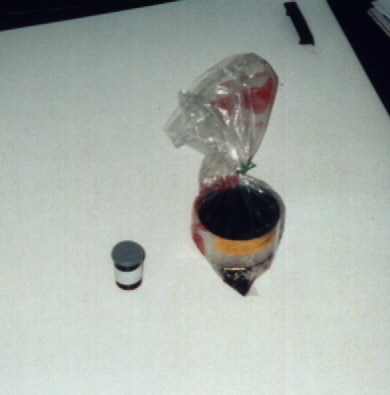
Thursday 20 april: I try to melt the pitch in a cola can of which I removed the top with a cutter. Alas, even after 15 minutes of heating, the pitch is only a little fluid (very sticky, like syrup). This is probably because the bottom of a cola can is not flat, so only a rather small part of it comes into contact with the surface of the cooking plate.

Saturday 22 april: At Hema I buy a small pan (0,75 liter, 14 cm diameter, 290 fr).
Wednesday April 26th: 9h20: I melt the pitch in the pan. Using some wood, I make a oblong rectangular shape and cover that with aluminium foil. The aluminium foil is painted with turpentine using a painters' brush, and then I pour the pitch in it. This takes about twenty minutes, then I remove the aluminium foil with the bar of pitch, which in the meantime has cooled down. Then I repeat the process, so now I've got two long bars of pitch.

Saturday April 29th:
21h15: I cut the two bars of pitch in square blocks. I use a cutter knife to
do this, holding it into the flame of a lighter---when the knife is too cold,
the pitch breaks in two (most of the time in a direction you don't want to
break it in) ... The aluminium foil is also hard to remove. Maybe I used
a little too much turpentine Wednesday on the aluminium foil; the pitch
sticks too much to the foil, and mostly at the corners, which is the place
where probably most of the turpentine went.
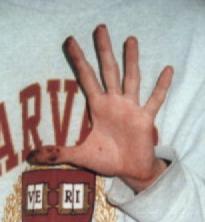
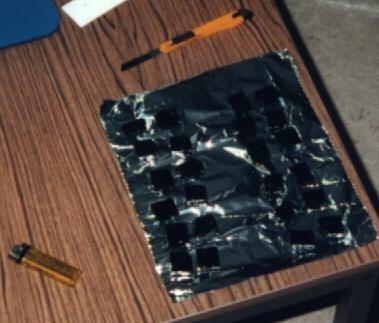
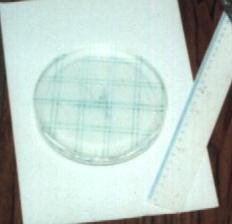

Monday May 1st: 10h30: I put a sheet of aluminium foil on the pitch lap, on top of that goes the mirror and the whole is pressed by a water bottle of 1.5 litres. After a few hours, not much difference is discernable. Na een paar uur is er nog niet erg veel verandering te zien.
Thursday May 4th: At 11 o'clock in the morning, I
have another look and what do we see: the pitch lap has very well taken
the shape of the mirror, but a lot of the pitch squares have come together
(they've been pressed flat so that they expand a little sideways).
8.00--10.00PM: I re-cut the squares. I use a cutter knife that I put into
the flame of a firelighter. This method will later on turn out to be rather clumsy.
One of the squares almost completely breaks off during the cutting; I manage
to fix it by putting it back on the glass disk and holding it into the flame
of the lighter, so it melts to the surface.
At 10PM, I let everything push again under the 1.5-litre bottle.
Friday May 5th
6.00PM: bottle is removed.
8.30--9.00: Re-cut the squares.
9.00--: bottle put on again.
Saturday May 6th
--11.30AM: bottle removed. The squares have again been pushed against each
other; it seems that I've been rather enthousiastic and such long pressing
times are not really necessary.
11.30--12.15: recutting squares; now I use another method: put the cutter
on the square at the place where it needs recutting, and give one (or
two or three) ticks with a hammer. The cutter works in other words like a
kind of chisel.
1.25--2.10: disks are pressed (as always by putting the water bottle on top
of the disks and letting gravity do its work).
5.35--7.35: polishing, MoT 1/3W. My method: put a bottle of water on top
of the mirror disk to apply pressure; the rest is more or less the same as
with grinding (the 1/3 W-stroke for example is exactle the same).
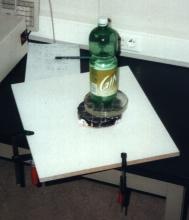

Tuesday May 9th:
7.25--7.35PM: recut squares.
7.35-8.00: pressing (now with a two-litre bottle of water).
8.00--10.30: Polishing, MoT, 1/3 W-stroke. I use a mixture of 7 teaspoons
of water and 1 teaspoon of powder. The first wet lasts about one hour;
at the end the motion is so difficult that a few bits of pitch
jump off; a bit of it sticks on the mirror! Washing this under
the faucet helps a bit, but not all the pitch goes away.
Happily ehough, the problem solved itself when I continued
with fresh water and powder.
Afterwards another half hour recutting the squares.
Friday May 12th
9.00--9.45PM: pressing
9.45--11.50: polishing (first wet lasts 1h5min). MoT, 1/3 W.
At the end, I clean the mirror with water, but a little fuzzy layer of
powder sticks to the surface, even after opening the faucet fully.
The solution is simple: before you stop polishing, do a few last strokes
with much water and almost no powder.
Saturday May 13th
1.25--1.50: Recut squares.
1.50--4.00: pressing (bottle of 1.5l together with the bottle of 2l)
5.20--6.10: idem
6.20--7.55: Polishing, MoT, 1/3W. The first ten minutes, everything goes
rather unfluid: the mirror shocks a little during the pushing and pulling.
The first wet lasts 1h10min.
Saturday November 5th The National Star Watch Days arrive again! Our friends of the VSRUG show a.o. their Foucault-tester, an occasion that we should not let pass of course! These experienced people have a look at the mirror and: only at the middle, the mirror is a little bit hyperbolic (solution: 15 to 20 minutes of polishing with a long 1/2 or 1/3 W-stroke)! All the rest is okay (no turn-down edge, no remains of pits on the mirror---so I've polished long enough---, no scratches)!